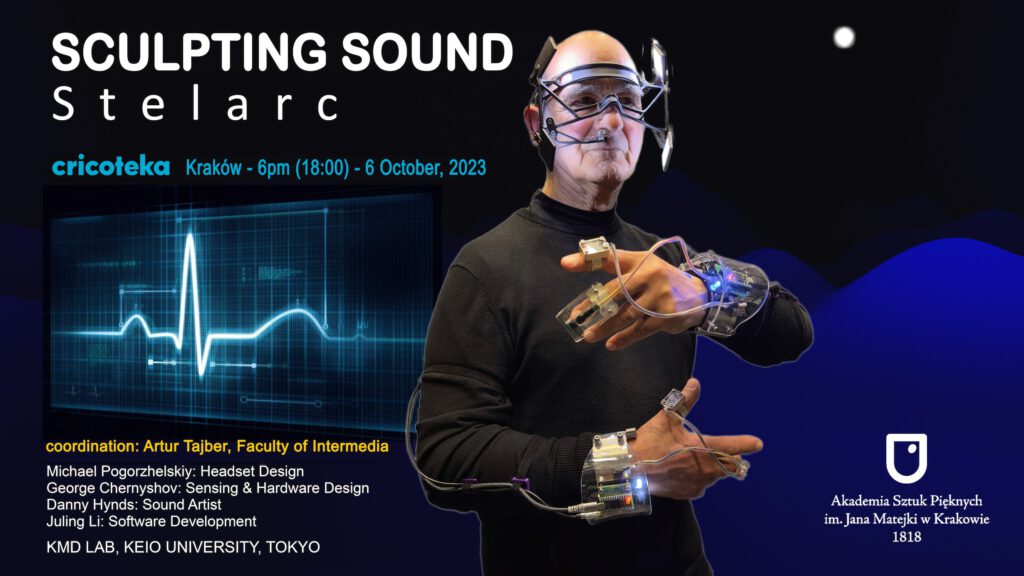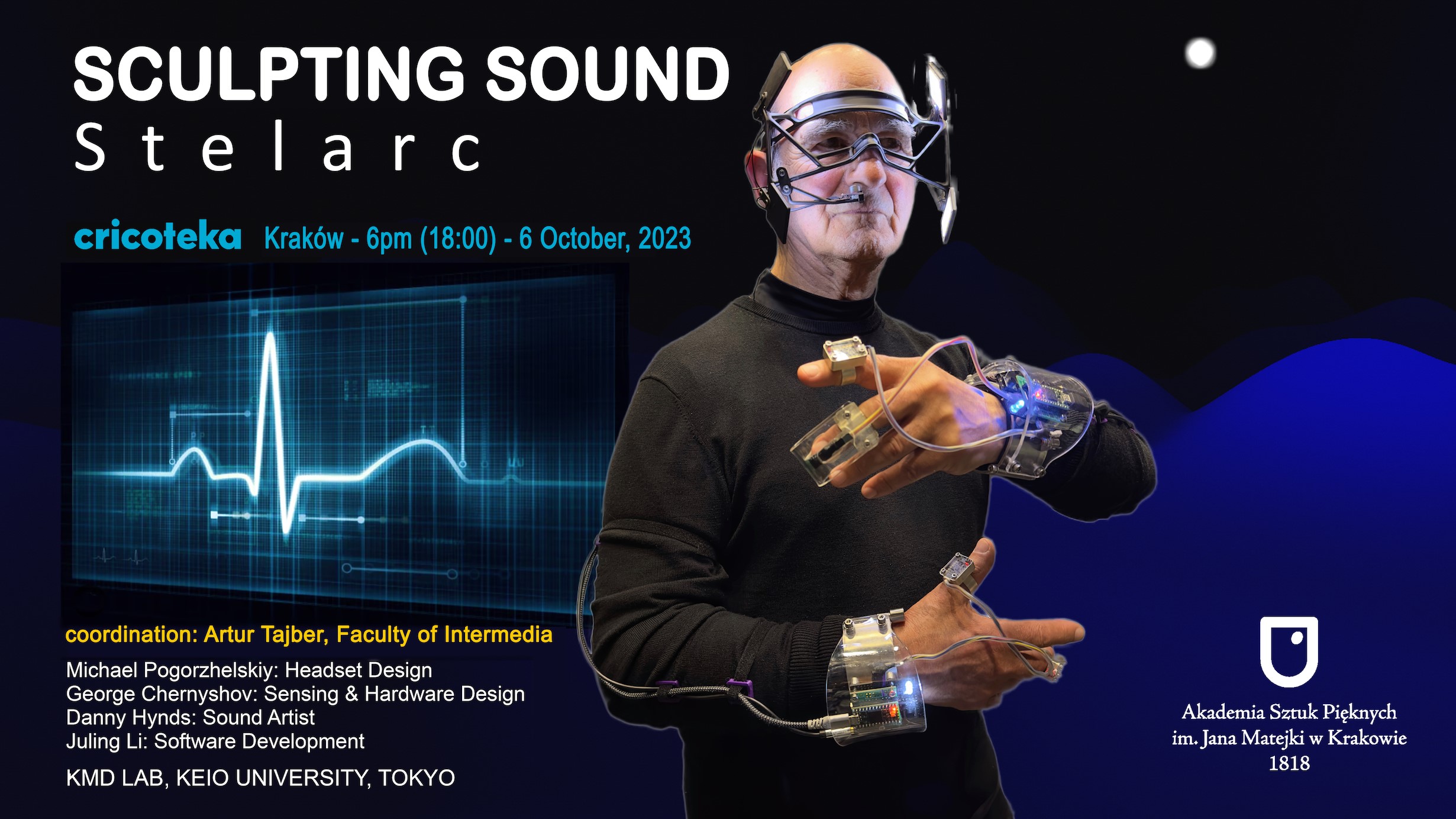
Wraz z Akademią Sztuk Pięknych w Krakowie i Open Eyes Art Festival zapraszamy na wystawę „Stelarc. Hacking the Human” i performance „Sculpting Sound”. Performance w Cricotece – 6 października o godz. 18:00. Wernisaż wystawy w Galerii ASP – 2 października o godz. 17.30, wystawa czynna od 2 października do 31 grudnia w Galerii ASP przy ul. Basztowej 18. Organizatorzy: Galeria ASP w Krakowie, Akademia Sztuk Pięknych im. Jana Matejki w Krakowie, Open Eyes Art Festival, we współpracy z Ośrodkiem Dokumentacji Sztuki Tadeusza Kantora CRICOTEKA, Wydziałem Intermediów ASP KRK.
Stelarc jest artystą performance, który bada i wzmacnia swoje ciało przy pomocy zaawansowanych technologii, który eksperymentuje z alternatywnymi architekturami anatomicznymi. Występował z Third Hand (Trzecia Ręka), Stomach Sculpture (Rzeźba Żołądka) oraz Exosceleton (Egzoszkielet), sześcionożnym robotem kroczącym. W internetowych performansach Fractal Flesh, Ping Body i Parasite badał mimowolną, zdalną i zdalnie sterowaną choreografię ciała przy użyciu elektrycznej stymulacji mięśni. Stelarc operacyjnie wszczepił w ciało komórki macierzyste, kształtując tak na swoim przedramieniu ucho, które uzyska elektroniczne wsparcie i dostęp do Internetu. Wśród ostatnich wystąpień twórcy znajdziemy ReWired/ReMixed,polegające na przekazywaniu funkcji zmysłów i dzieleniu się doznaniami. Artysta uzyskał liczne tytuły honorowe uczelni wyższych na całym świecie; w 1996 r. został honorowym profesorem sztuki i robotyki na Uniwersytecie Carnegie Mellon, w 2002 r. otrzymał tytuł doktora honoris causa Uniwersytetu Monash, w 2010 roku otrzymał nagrodę Ars Electronica Hybrid Arts Prize, w 2015 roku nagrodę Australia Council’s Emerging and Experimental Arts Award, w 2016 r. uzyskał tytuł doktora honoris causa Uniwersytetu Jońskiego na Korfu. W 2023 roku Senat Akademii Sztuk Pięknych im. Jana Matejki w Krakowie przyznał mu tytuł doktora honoris causa.
Twórczość Stelarca jest reprezentowana przez Scott Livesey Galleries, Melbourne.
*****
„Żyjemy w epoce nadmiaru i obojętności oraz upowszechnienia protetyki. Ciało stało się współczesną chimerą mięsa, metalu i kodu, działającą poza granicami skóry i poza lokalną przestrzenią, którą zamieszkuje. W tym technologicznym obszarze ciało wymaga sensorycznego, maszynowego i obliczeniowego rozszerzenia. Pojawia się konieczność alternatywnych konstrukcji anatomicznych. W erze hakowania ciała, mapowania genów, protezowania, wymiany organów, przeszczepów twarzy, syntetycznej skóry to, co oznacza bycie ciałem, co oznacza bycie człowiekiem i co generuje żywotność i sprawczość, staje się problematyczne. W przestrzeni mnożących się ciał protetycznych, częściowego życia i sztucznego życia, ciało biologiczne staje się głęboko przestarzałe. Ciało traci podmiotowość. Ciało nie jest już obiektem pożądania, ale raczej ciałem, które wymaga ponownego wyobrażenia i przeprojektowania.
Obecnie ciało doświadcza siebie jako mimowolne, zautomatyzowane i nieobecne w swoim własnym działaniu. Ciało jest teraz zdalnie sterowane i rzutowane w odległe przestrzenie. Jego świadomość może zostać usunięta, a jego fizyczność zanika. Staje się ono rozszerzonym systemem operacyjnym. Nie funkcjonujemy już „całkowicie
tutaj” w tym ciele ani „całkowicie tam” w tamtym ciele, ale czasami „częściowo tutaj” a innym razem – „częściowo tam. Obecność staje się też problematyczna. Obecność jest naznaczona podwójną nieobecnością, a może nieobecność jest naznaczona podwójną obecnością. Świadomość prześlizguje się między przestrzeniami i sytuacjami, płynnie oscylując między tym, co rzeczywiste, a tym, co wirtualne. Nadal występujemy jako ciała biologiczne – offline – i ciała fantomowe – online. Fantomy nie jako fantazmaty, ale raczej jako fantomowe
kończyny. Jaźń umiejscawia się poza skórą, ciało zostaje opróżnione. Lecz pustka ta nie jest pustką braku, ale raczej radykalną pustką poprzez nadmiar. To pustka wynikająca z wyciskania i rozszerzania jego możliwości, jego poszerzonych anten sensorycznych i jego coraz bardziej zdalnego funkcjonowania. Ważna staje się nie tylko tożsamość ciała, ale też jego łączność – nie mobilność czy lokalizacja, lecz interfejs”.
Stelarc, 2023
Tłum. prof. Artur Tajber
Prace prezentowane na wystawie dzięki uprzejmości artysty.
Specjalne podziękowania:
J.E. Lloyd Brodrick Ambasador Australii w Polsce | Mr Lloyd Brodrick Australian Ambassador to Poland
prof. Artur Tajber
We invite you to an exhibition „Stelarc. Hacking the Human”. EXHIBITION: 02.10–31.12.2023; OPENING: 02.10.2023, 17:30, Galeria ASP w Krakowie, ul. Basztowa 18, 31-157 Kraków.
PERFORMANCE : 06.10.2023, 18:00, Ośrodek Dokumentacji Sztuki Tadeusza Kantora CRICOTEKA | the Centre for the Documentation of the Art of Tadeusz Kantor CRICOTEKA, ul. Nadwiślańska 2-4, 30-527 Kraków
Organised by:
Galeria ASP w Krakowie
Akademia Sztuk Pięknych im. Jana Matejki w Krakowie
Open Eyes Art Festival
Cooperation:
Ośrodek Dokumentacji Sztuki Tadeusza Kantora CRICOTEKA
Wydział Intermediów ASP KRK
Stelarc experiments with alternative anatomical architectures. He has performed with a Third Hand, a Stomach Sculpture and with Exoskeleton, a 6-legged walking robot. Fractal Flesh, Ping Body and Parasite are internet performances that explore remote and involuntary choreography. He is surgically constructing and stem-cell growing an ear on his arm that will be electronically augmented and internet enabled. Recent performances include ReWired / ReMixed that incorporates an outsourcing of his senses and a sharing of his agency. In 1996 he was made an Honorary Professor of Art and Robotics, Carnegie Mellon University and in 2002 was awarded an Honorary Doctorate of Laws by Monash University. In 2010 he was awarded the Ars Electronica Hybrid Arts Prize. In 2015 he received the Australia Council’s Emerging and Experimental Arts Award. In 2016 he was awarded an Honorary Doctorate from the Ionian University, Corfu. In 2023, he was awarded an Honorary Doctorate by the Senate of the Jan Matejko Academy of Fine Arts in Krakow, Poland.
His artwork is represented by Scott Livesey Galleries, Melbourne.
*****
„We are living in an age of excess and indifference and of prosthetic proliferation.
The body has become a contemporary chimera of meat, metal and code, performing beyond the boundaries of the skin and beyond the local space it inhabits. In this technological terrain the body requires sensory, machinic and computational augmentation. The necessity for alternative anatomical architectures. In this age of body hacking, gene mapping, prosthetic augmentation, organ swapping, face transplants, synthetic skin, what it means to be a body, what it means to be human and what generates aliveness and agency becomes problematic. In the spaces of proliferating Prosthetic Bodies, Partial Life and Artificial Life, the biological body become profoundly obsolete. The body is no-body at all. The body is no longer an object of desire, but rather a body that requires re-imagining and re-designing. The body now experiences itself as involuntary, automated and absent to its own agency. The body is now
remotely propelled and projected into remote spaces. Its awareness can be extruded and its physicality recedes. It becomes an extended operational system. We no longer function “all-here” in this body nor “all-there” in that body but “partly-here” sometimes and “partly-there” other times. Presence now becomes problematic. Presence is marked by a double absence, or perhaps absence is marked by a double presence. Awareness slips and slides between spaces and situations, oscillating seamlessly between the actual and the virtual. We continue to perform as biological bodies offline and phantom bodies online. Phantoms not as phantasmatic but rather as phantom limbs. The self becomes situated beyond the skin, and the body is emptied. But this emptiness is not an emptiness of lack but rather a radical emptiness through excess. An emptiness from the extrusion and extension of its capabilities, its augmented sensory antennae and its increasingly remote functioning. What becomes important is not merely the body’s identity, but its connectivity – not its mobility or or location, but its interface.”
Stelarc, 2023
Works presented at the exhibition by the courtesy of the artist
Special Thanks to:
J.E. Lloyd Brodrick Ambasador Australii w Polsce | Mr Lloyd Brodrick Australian Ambassador to Poland
prof. Artur Tajber


